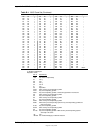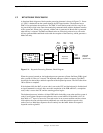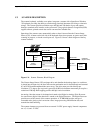
Appendix C Keyboard
Compaq Personal Computers
Changed - November 1996
C-8
C.2.3.2 Multi-Keystroke Functions
Shift
- The
Shift
key (pos. 75/86), when held down, produces a shift state (upper case) for keys
in positions 17-29, 30, 39-51, 60-70, and 76-85 as long as the
Caps Lock
key (pos. 59) is
toggled off. If the
Caps Lock
key is toggled on, then a held
Shift
key produces the lower
(normal) case for the identified pressed keys. The
Shift
key also reverses the
Num Lock
state of
key positions 55-57, 72, 74, 88-90, 100, and 101.
Ctrl
- The
Ctrl
keys (pos. 92/96) can be used in conjunction with keys in positions 1-13, 16, 17-
34, 39-54, 60-71, and 76-84. The application determines the actual function. Both
Ctrl
key
positions provide identical functionality. The pressed combination of
Ctrl
and
Break
(pos. 16)
results in the generation of BIOS function INT 1Bh. This software interrupt provides a method of
exiting an application and generally halts execution of the current program.
Alt
- The
Alt
keys (pos. 93/95) can be used in conjunction with the same keys available for use
with the
Ctrl
keys with the exception that position 14 (
SysRq
) is available instead of position
16 (
Break
). The
Alt
key can also be used in conjunction with the numeric keypad keys (pos. 55-
57, 72-74, and 88-90) to enter the decimal value of an ASCII character code from 1-255. The
application determines the actual function of the keystrokes. Both
Alt
key positions provide
identical functionality.
The combination keystroke of
Alt
and
SysRq
results in software interrupt 15h, AX=8500h
being executed. It is up to the application to use or not use this BIOS function.
The
Ctrl
and
Alt
keys can be used together in conjunction with keys in positions 1-13, 17-34, 39-
54, 60-71, and 76-84. The
Ctrl
and
Alt
key positions used and the sequence in which they are
pressed make no difference as long as they are held down at the time the third key is pressed. The
Ctrl
,
Alt,
and
Delete
keystroke combination (required twice if in the Windows environment)
initiates a system reset (warm boot) that is handled by the BIOS.


















